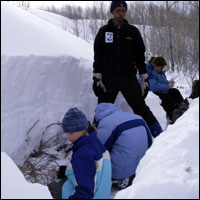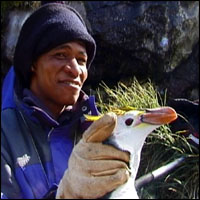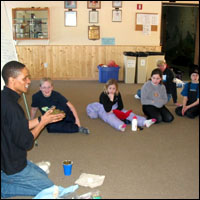Elwandle's Dumile plans to take environmental science to society
|
Dumile Tshingana, the SAEON Elwandle Node’s newly appointed education
outreach officer, is a man with a mission. He wants to educate the
people of the Eastern Cape who live in remote rural areas about the
environment and the importance of conserving and protecting the natural
beauty of the places where they live.
Born in Ntabankulu (“Great Mountain”) on the Eastern Cape Wild Coast, one of the most beautiful stretches of coastline in southern Africa, Dumile was exposed to coastal forest and marine environments and the creatures that dwell here from an early age.
As a young learner, he went to visit relatives employed at the Umkhambati Nature Reserve during school holidays, where he negotiated piece jobs for himself assisting tourists and researchers. This enterprising youngster’s knowledge of the best camping and fishing spots along the coastline made him a popular guide, and he soon found himself assisting marine biologists from Sea World in Durban with small tasks and errands. This, says Dumile, was where his interest in environmental science was first kindled.
Dr Rudy van der Elst, chief scientist at the Oceanographic Research Institute at the time, who frequently visited the Transkei Coast, became his mentor, and it was almost a natural progression for Dumile to start work at Sea World, the aquarium of the South African Association for Marine Biological Research, as soon as he had matriculated.
While studying part-time for his first national diploma in Nature Conservation, he became a dolphin and seal trainer and show presenter. “I really enjoyed working with these intelligent animals,” says Dumile, “and I was amazed at how quickly they learn.”
The dolphins and seals were almost entirely in his care, which entailed feeding them and monitoring their health - quite a responsibility for such a young student. And he got bitten by dolphins on several occasions. “They display strange, quite aggressive behaviour during the breeding season of dolphins in the wild,” says Dumile, “and then you have to be careful to stay out of their way.”
At Sea World he met Judy Mann, a marine biologist with an interest in education outreach, who was to change the course of his career. Judy travelled to rural areas throughout the Eastern Cape to educate people about the environment and she sparked Dumile’s interest in education outreach with her passion and enthusiasm.
“So, after three year as an ‘entertainer’ it was time to make a change,” says Dumile with a chuckle. He joined the education science centre which was managed by Judy and went out on field trips to Transkei and KwaZulu-Natal visiting schools and teaching learners about the environment.
He also went back to his roots along the Transkei Coastline to Haga Haga to spread the conservation message to learners and adults alike. “We talked and they could see the benefit of sustaining the natural resources,” says Dumile. He also introduced them to some monitoring projects and initiated a number of long-term monitoring and data collection programmes at schools.
But after two years it was time to spread his wings. “I wanted to learn more about science and get really involved in scientific activities,” he explains, and then grins, “and I wanted to experience some of those extreme adventures one only reads about in books.”
And where better than Marion Island in Sub-Antarctica? “That was very extreme,” Dumile admits, “and just sometimes, scraping penguin droppings from my boots, I wondered what on earth made me do it?”
To enable an expedition team to survive on the island, they have to attend a rigorous training course organised by the Department of Environmental Affairs and Tourism in partnership with the South African National Defence Force in Pretoria.
Employed by Marine and Coastal Management (then still known as the Sea Fisheries Institute), he was involved in monitoring the four penguin species on the island – king penguins (the world’s second largest penguin species), macaroni penguins, rockhopper penguins and gentoo penguins.
“If you thought dolphins can bite you should have seen these penguins,” says Dumile. “They nailed me on my feet while I was walking between their nests to monitor them.”
He was also responsible for conducting regular censuses of the petrels on the island to monitor population dynamics and breeding success. “And boy, did they nail me while I was recapturing and marking them for research,” he says.
The petrels came in from the ocean to breed on the island and he monitored them from their arrival through their breeding period and the hatching of the eggs until the time they left the colony. In the bitter cold temperatures, snow and raging winds reaching up to 160 km an hour, it took him anything from two to three hours through ice pellets and rough terrain to reach the colonies, only to spend four to five minutes at each one. Every ten days he did a round-island trip, sleeping in one of the nine field huts on the island.
“And if you’re really skinny like me, you have to weigh yourself down by carrying a heavy backpack to anchor yourself in such winds,” he explains.
After fourteen months on the island, he left for America on a scholarship to study Environmental Education at the Hamline University in Minnesota. “They know how to take science out to society,” says Dumile. The University’s research centre functions as a hub for science communication within the university and to schools. Science staff visit schools, schools visit the research centre for up to a week at a time, regular programmes are presented where lecturers give talks and students in Environmental Education do their practicals.
“I had to design programmes myself, based on the course content and in line with what a particular school wanted to learn,” explains Dumile, “and that could be very broad-ranging.”
But, contrary to his expectations, he missed “that island”. “I needed to be in that wilderness again,” he says with a rueful smile. “I missed the solitude and the peaceful environment.”
So back he went, for another fourteen months. After that, and after spending two months with his family, he returned to America for a year on an international scholarship to complete his Masters degree at the University of Wyoming.
“It was very cold in this Cowboy country, it was very tough, and there were lots of snow, but it was a thoroughly worthwhile experience,” says Dumile of this period in his life. Although the course was similar to the previous one, the underlying philosophy was different – instead of environmental education he was now involved in environmental science education, which combined teaching with interpretation of the environment.
“While we were out field guiding, we had to follow specific themes, and these had to be related to people’s personal and everyday lives,” he explains. His practical work took him to the Yellowstone National Park and Grand Teton National Park in Wyoming, where he conducted specialized tours on, for example, the geography and birds of the area, and conservation biology.
“This is an amazing programme,” says Dumile, “and South African parks can do well to learn from that.”
Dumile describes the interaction between park staff, environmental education officers and the public as a win-win situation, with the parks promoting their programmes, whilst simultaneously informing and educating national and international tourists. He found it a hugely interesting experience from a science education point of view.
“Involved as I was in environmental studies before the time, it changed my perception and feelings about looking after our planet’s natural resources,” Dumile explains. “Before, I was equipped with skills and knowledge to take to the people, but I was not yet ready to take scientific practices to people and change their lives.”
The experience brought the impact of global warming deeply home to him. “Global warming is happening, and at a very fast rate,” he says with a serious undertone, “and we need to change the way we are living on this Earth.” He sees it as his mission to raise awareness about climate change and its many contributing factors. “I want to mobilize people into action,” he says, “so that we can start mitigating our effect on our environment.”
Although Dumile, who joined the SAEON Elwandle Node on 2 May, will be based in Grahamstown, he will be responsible for education outreach in virtually all areas of the Eastern Cape.
“This is a great thing for me,’ he beams, “as I have always wanted to put something back into my own community in the Eastern Cape.”
For a beginning, he will aim to create a platform or framework that will assist in providing Eastern Cape Education with science education activities. He is envisaging special courses for educators so that they are equipped to take the information to their learners.
“I want to establish a cluster of key educators in the region with whom I’ll be working very closely,” he says. “There is a big need to create awareness of science as a career. Most of the young people in the region do not even vaguely consider science as a career, mostly because they are ignorant about what it entails.”
Dumile is already regarded as something of a role model in his own community in the Transkei, a role he accepts without demur. “Children want to see tangibles,” he says, “and it is important for them to associate with real people.”
He also needs to identify opportunities for collaboration with other organizations concerned with environmental research and monitoring in the region, and become part of that network.
For now, Dumile has placed any further studies on hold. He first needs to establish a firm footing in his new job. “But I definitely want to do a PhD,” he says, “possibly something to do with long-term environmental monitoring and observation.” He says that the topic will evolve as he gains new insight into his new programme.
But first he wants to take environmental science to society.














